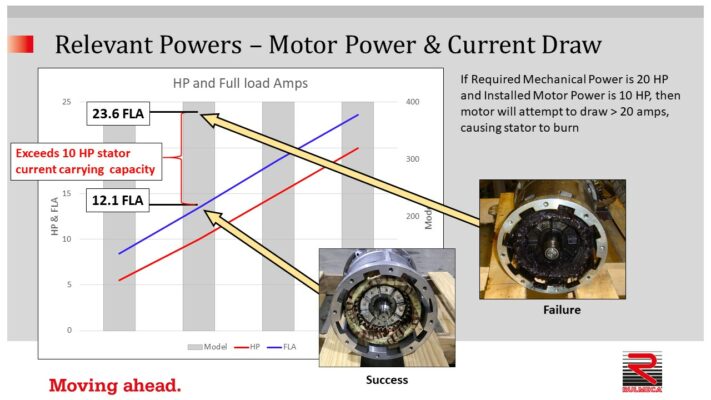
It is essential that the conveyor operators and designers be aware of the important relations between motor power and current draw. It is also important to understand the relationship between motor rotor RPM and conveyor drive heat dissipation capability.
ABOUT RULMECA CORPORATION
We supply Motorized Pulley belt conveyor drives, serving equipment manufacturers directly and end users through a network of independent distributors & local service providers throughout the United States and Latin America.
In this discussion, we will assume motor torque to be constant. Years ago, we suggested the frequency spectrum be restricted to 12 to 66 Hz. Today, since flux vector VFDs are very common, we can extend the allowable spectrum, but it is best to check with the VFD manufacturer to establish actual torque at the desired extremes of the frequencies you need. Note also that the frequency setting may affect motor cooling.
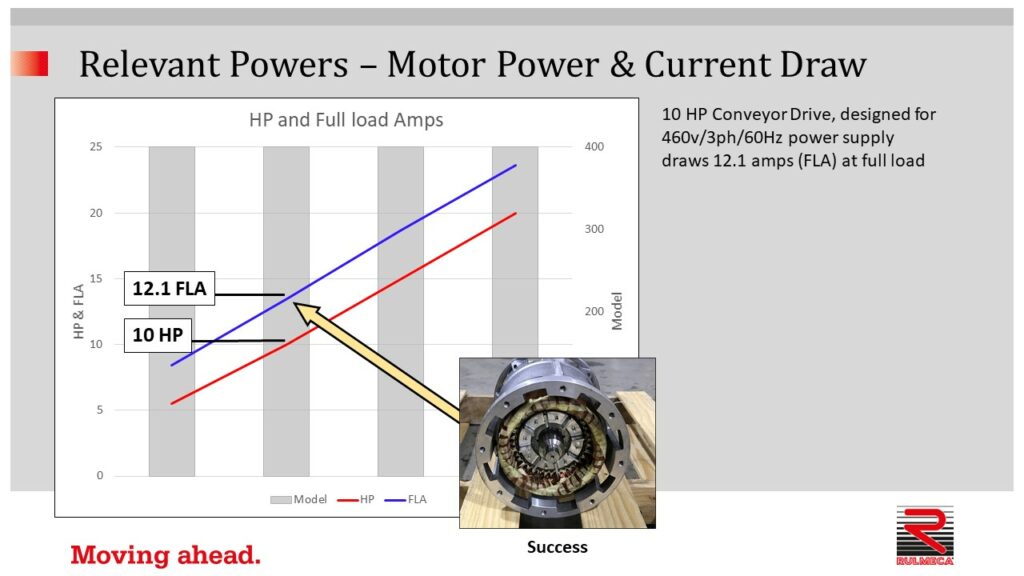
Power and current draw in AC Squirrel-Cage induction motors are linearly proportional. This 10 HP motor draws 12.1 amps at full load (FLA) on a 460v/3ph/60Hz power supply. If the 10 HP motor is required to provide 20 HP of mechanical power, it will draw 23.6 FLA and burn unless an external overcurrent protection switch limits current draw to 12.1 amps.
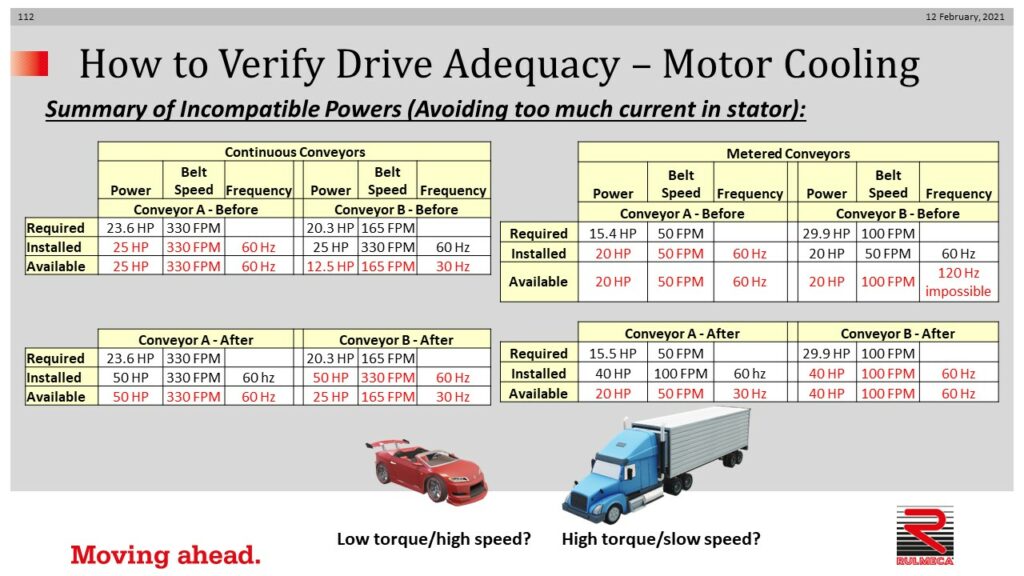
Here is a summary of solutions to the four examples.
In the continuous conveyor, a 25 HP motor, originally installed to provide 25 HP at a 330 fpm belt speed at 460v/3ph/60 Hz, could not provide 20.3 HP at a 165 fpm belt speed at 460v/3ph/30 Hz because available power was limited to 12.5 HP, as shown below.
Required power at 165 fpm = 20.3 HP
Available power at 165 fpm = 25 HP x 30Hz/60Hz = 12.5 HP
Required power exceeds available power
We solved the problem by installing a 50 HP drive system, designed to provide 50 HP at a 330 fpm belt speed at 460v/3ph/60 Hz. Available power when running the drive at 60 Hz or 30 Hz is now adequate.
Required power at 330 fpm = 23.6 HP
Available power at 330 fpm = 50 HP at 60 Hz
Required power at 165 fpm = 20.3 HP
Available power at 165 fpm = 50 HP x 30 Hz/60Hz = 25 HP at 30 Hz
When evaluating drives at two extremes of speed, size the high speed drive first, then check drive adequacy at the slow speed.
In the metered conveyor, a 20 HP motor, originally installed to provide 20 HP at a 50 fpm belt speed at 460v/3ph/60 Hz, could not provide 29.9 HP at a 100 fpm belt speed at 460v/3ph/120 Hz because available power was limited to 20 HP, as shown below.
Required power at 100 fpm = 29.9 HP
Available power at 100 fpm = 20 HP (because 120 Hz is impossible)
Required power exceeds available power
We solved the problem by installing a 40 HP drive system, designed to provide 40 HP at a 100 fpm belt speed at 460v/3ph/60 Hz. Available power when running the drive at 60 Hz or 30 Hz is now adequate.
Required power at 50 fpm = 15.5 HP
Available power at 50 fpm = 40 HP x 30 Hz/60Hz = 20 HP at 30 Hz
Required power at 100 fpm = 29.9 HP
Available power at 100 fpm = 40 HP at 60 Hz
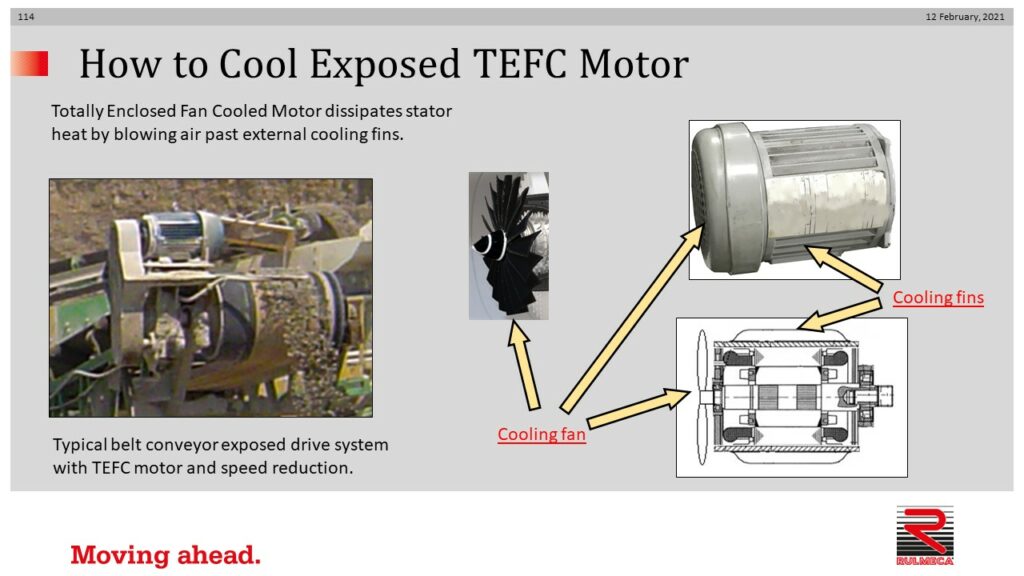
Now let’s review motor cooling at various power supply frequencies. A TEFC Motor is designed so that an external fan blows ambient air across cooling fins cast into the external surface of the motor frame. The fan is designed to blow a certain quantity of air, measured in cubic feet per minute, (CFM) at the design power supply frequency. If rotor RPM is reduced too much, it is possible that available CFM will be inadequate to cool the motor. When in doubt, check with your motor supplier.
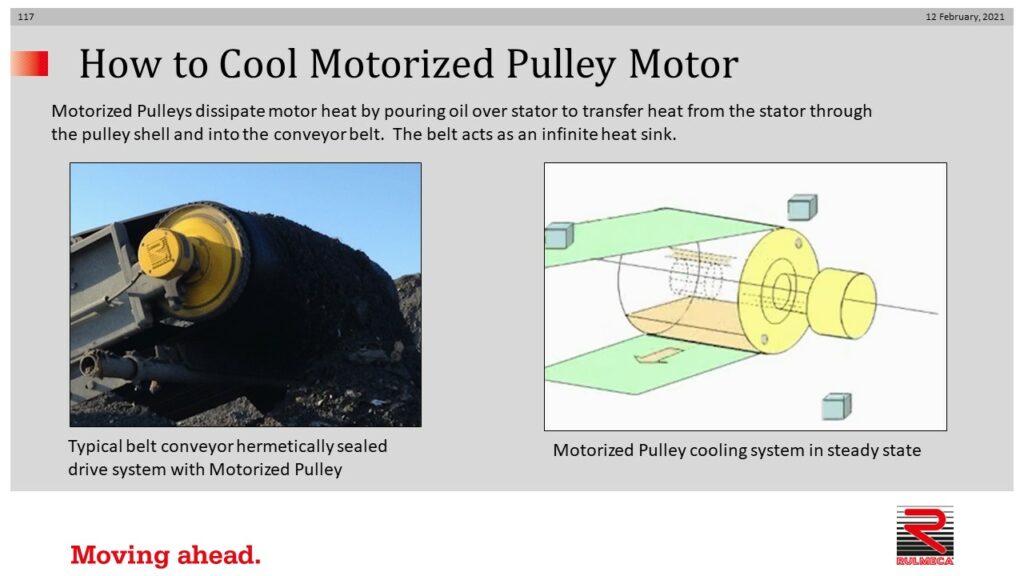
Motorized Pulleys use the flow of oil to cool the stator. Drip lips, which work like a water wheel, continuously pour oil on the stator. The oil pulls heat from the stator into the oil at the bottom of the pulley, continuously transferring heat through the pulley shell and into the conveyor belt. The belt serves as an infinite heat sink.
Rulmeca Motorized Pulleys use motors designed to run on a variety of power supplies (e.g. 460v/3ph/60Hz). The product portfolio includes 2, 4, 6, 8, and 12 pole motors. It also includes pulley RPMs from 7 to 452 RPM. In all combinations of standard power supply and pulley RPM oil flow will be adequate to cool the motor. However, if supply frequency is decreased too much (e.g. 2 Hz) the pulley will not pour an adequate quantity of oil on the stator to cool it. One of our customers actually required a 2 Hz power supply to drive a hopper feeder conveyor. In that case, it was necessary to install an external source of air to blow ambient air over the pulley face.
And at the other end of the spectrum, if the pulley is spun too fast, then centrifugal force will force oil against the inner wall of the pulley shell, preventing from flowing onto the stator. When in doubt, contact your Motorized Pulley supplier.
